Angels of Mercy?
Angels of Mercy? (1995, London, England)
In 1995 Channel 4’s Warcries news program aired Angels Of Mercy?, a 30 minute investigation into the Animal Liberation Front. The show focused primarily on Keith Mann, an ALF volunteer who was then serving England’s longest sentence for animal rights motivated arson. While most commercially funded news has a clear bias in favor of the status quo (and the channels sponsors,) Warcries was known for fairer journalism. The result in this case was a surprisingly sympathetic look at what pushes a young person to commit criminal acts on behalf of non-humans. Given developments since it first aired, it also serves as a remarkable lesson about public credibility and how difficult it is to regain once lost.
In the 1990s our movement had a variety of articulate, savvy spokespeople, and the release of Angels of Mercy? quickly made Keith Mann foremost among them. His voice-overs from a prison phone are heard over shocking footage of animal abuse, and interviews with his family and supporters act to assure the audience that he is a rational and passionate activist working to stop what can only be described as horrific cruelty. When Keith was later released from prison he was highly sought after as a speaker and a source for reporters. I always felt reassured when I saw his face in the news since I knew it meant that at least one positive quote would make it’s way to the public.
Sadly, in the last few years Keith has become a devotee of British new-age guru David Icke, a man who believes that a race of reptilian shape-shifters secretly controls the world, that cancer is a fungus, that some humans are actually half-dead, inter-dimensional beings, and a host of other pseudo-scientific nonsense. After being literally laughed off of television in 1991 when he wrongly predicted the end of the world, he has resurfaced in recent years as a lecturer and author with a depressing number of followers.
Since his conversion to odd-ball conspiracy theorist Keith Mann has lost much of his credibility both inside and outside the movement. Most recently he has become a holocaust denier, thereby severing his ties with many of us who still held some hope that he would come to his senses. It’s a shame, because as I watch Angels of Mercy? I am reminded of the rare power he once had to make everyday people understand direct action and animal liberation, a power whose benefit is now lost to the animal nations. It is my hope that by posting this video others will consider how desperately the animals need trustworthy advocates, and how easy it is to damage that trust.

The Black Cat Sabotage Handbook
The Black Cat Sabotage Handbook, 3rd edition (1996, Eugene, OR.)
When I was a kid the world didn’t have the sort of instant gratification now expected for all transactions, and thank goodness. You can really appreciate the value of something more once you’ve clipped five proof of purchases, put them into an envelope, mailed them away, and waited 6 to 8 weeks for your Zartan action figure to arrive. Distribution for the Black Cat Sabotage book worked the same way – you clipped an ad out of a zine and mailed it in along with concealed cash. A few months later a copy showed up in a nondescript envelope. I still remember when mine was delivered…
My first copy of Black Cat left me feeling like I was involved in some sort of conspiracy just turning the pages. Sure, most of it was reprints that I had already seen before, but the layout, the graphics, and the text all seemed to carry the message that action was urgent and that the enemy was watching. (Of course, we were all sending envelopes with our return addresses to the same damn PO Box in Eugene, so if anyone was watching they already knew who we were!) At the time I didn’t know who was publishing or distributing it, but rumors eventually surfaced in the mid 2000’s that the book was compiled by Bill Rogers, an accused Earth Liberation Front member who took his own life behind bars in 2005. In his suicide note he said that his death was a “Jail break,” and as he slowly suffocated himself with a plastic bag he gripped one hand into a fist, and with the other, extended his middle finger.
I only met Bill one or two times and did not get to know him well, but since his death I have heard many complicated things about him. From what I gather he was at times heroic, but had some serious, perhaps unforgivable flaws that should not be ignored. In that respect he is like the book that he was rumored to have clipped together and sent out anonymously. The Black Cat Sabotage Handbook contains some good bits of information, some serious inspiration, and some decent arguments for the use of sabotage and even violence. Likewise, it also contains some foolhardy nonsense that could get someone jailed or killed for little positive gain. The cover shouts, “BEWARE!” and smart readers will heed that advice.
In closing, here is to Bill. He was a man I can best respect by keeping off a pedestal. I can not deny that many of the stories about him are disconcerting, but I also can not deny the beauty of his attempts to spark a revolution against industrialism. As his friends sat shivering and complaining in a car, it was Bill who trekked alone through snow, uphill and burdened with the weight of gallons of fuel to set a fire that would announce to millions the existence of the Earth Liberation Front. That speaks volumes about his fighting spirit, and his wild drive to right the wrongs our species has perpetrated. His death saddens me, but something tells me that someone so intent on freeing others would not have done well spending decades behind bars- perhaps in that sense his “jail break” really was a form of escape. He will be remembered as a warrior.
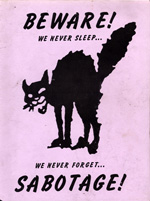 |
How to Speak Australian
Action For Animals newsletter #1-3 (1985 – 1986. Queensland, Australia.)
Agitator #1 (1987. Eltham, Australia.)
Action Reports #1 (1987. Eltham, Australia.)
Direct Action for Animal Rights newsletter #5-6 (1985 – 1986. Lutwyche, Australia.)
Despite his denouncement of most forms of illegal direct action, Peter Singer has played an interesting and unintended role in the history of the underground in his native Australia. After the success of his seminal utilitarian philosophy book, Animal Liberation, he founded a group by the same name in the land down under. This left some activists with an interesting question: should they continue using the name “Animal Liberation Front?” Many cells decided to forgo the confusion of a nearly identical moniker and instead acted under the banner of Action for Animals and Direct Action for Animal Rights.
Australia was one of the first countries outside of England to see resistance movements dedicated to non-humans. As raids and economic sabotage became more frequent, above ground supporters started small press publications to publicize the tactics and activities of these Aussie warriors. Later, as arrests began to mount, these publications also served to raise defense funds and promote acts of solidarity with animal rights prisoners.
Conflict Gypsy is hoping to track down complete sets of all the magazines featured in this post. If you can help us find them, please contact us at conflictgypsy (at) gmail (dot) com
 |
 |
 |
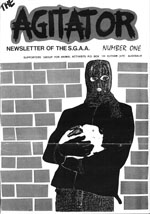 |
||
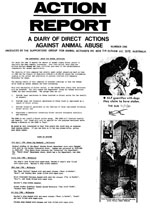 |
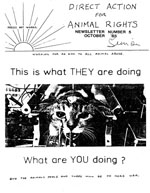 |
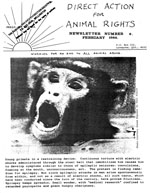 |
The Animal Liberation Front Supporters Group newsletter #17
The Animal Liberation Front Supporters Group newsletter #17 (1985, London, England.)
(Editors note: The complete set of SG newsletters is now available HERE.)
It is not usually our habit to put up a single issue of a serialized publication as we prefer to post an entire year, or run of magazines, in a single post. However, we must make an exception for the ALF SG newsletter #17, which contains a fantastic investigation of the Band of Mercy and comes complete with an image of their first press statement from November of 1973. The significance of that image, the very first communique from an underground group fighting on behalf of other species, can not be understated.
When one considers how entrenched animal exploitation is in our culture, the idea that a tiny band of revolutionaries could push back against that social tide by burning down an animal laboratory under construction is a watershed moment. The arson attacks and raids carried out by the Band of Mercy were pivotal in the creation of the animal rights movement.
This issue has much more in store for readers. The second communique from the Animal Rights Militia is presented in it’s entirety, and although it provides a myopic examination of the role of liberatory violence it is none the less a fascinating read for lovers of animal rights history. The story of the famous Ecclesfield Beagle raid is presented by one of it’s participants, Roger Yates has a long letter explaining his feelings on the uselessness of national groups, and funny pseudonyms abound! If you thought Earth First!ers had funny names, wait till you get a load of Captain Kirk, Martial Rose, and Black Vixen!
If you look carefully you may notice that this issue is missing some pages. We do not know if this is because they were removed by their original owner, or if this is one of the issues of the SG rumored to have been “edited” by the British government as it left post offices on it’s way to subscribers.
 |
Love and Anger, 1st and 2nd Editions
Love and Anger, 1st and 2nd Editions (1980?, Westport, CT. USA)
“Animals have rights, interests, desires, and needs equal, within the context of their lives, to those of humans, and we have an obligation to recognize this, and act accordingly. Animal Rights is a philosophical orientation, and a practical necessity if creatures are to be spared the systematic cruelty to which they are currently subjected. But perhaps most importantly, the designation of and agitation for animal rights is part of a revolutionary process aimed at restructuring the major institutions of our society. Indeed, in struggling to change the way humans treat animals, and one another, we work towards nothing less than the transformation of the world.”
– Richard Morgan, from the introduction.
For the last several years, I have been trying to understand why the animal rights movement rode a wave of success in the early 80s, only to fall so sharply by the end of the decade. This inquiry has led me to read old books and magazines, to interview participants from that time period, and even to reading the history of other causes in an attempt to find parallels in their peaks and troughs. I still have not arrived at a conclusive answer to the question, and it appears that many factors played a part in our recession. What is more clear, though, is that one figure played a major role in our rise, only to be quickly forgotten. His name is Richard Morgan, and after working towards civil rights and an end to the war in Vietnam, he took up the cause of animal rights in the late 1970s.
Early figures in the movement speak of Morgan as a pioneer, and his group, Mobilization for Animals, planned some of the largest and most visible demonstrations of the time, drawing thousands of people to multiple locations across the United States. He introduced his organizing model in 1979 with the the first edition of Love and Anger, a book which many people in the fledgling animal rights community cited as their inspiration to start a local group.
Written in a style that blends 70s leftism with 80s self-help jargon, Love and Anger can, at times, be a frustrating read. Morgan certainly has a touch of the arrogant liberalism that repulsed the generation of activists that followed his into the 90s. Scattered throughout the book are unsupportable claims, like American pacifists ending the war in Vietnam with sit ins, and new-agey feel good calls for demonstrations to provide “spiritual nourishment.” Some of the book’s advice is remarkably egalitarian, including calls for work within a group to rotate and for everyone, even supposed leaders, to do “shit work.” But some of the book is strangely authoritarian, with calls for “marshals” at demonstrations to squelch the spontaneous actions of others present. If a reader can get past these snags this book also contains a lot of wisdom.
Written at a time when there was almost no movement to speak of in the United States, the author set out to make a handbook to teach people who had never held a sign before to grow a resistance from scratch. He was concerned about the personal and political development of each new member of this tiny cause, and wanted them to think big. Four years before the first civil disobedience action for animal rights (which took place in New York at the Macy’s Fur Department, not in Sacramento as widely reported elsewhere), Richard Morgan wrote about developing personal courage to face law enforcement and overcome private doubts about organizing ability. He gave practical advice on bringing out large numbers to demonstrations, making literature, contacting media and writing press releases, and other basics that helped make animal rights the breakout issue of the 1980s.
Richard Morgan disappeared from activism in the mid 80s. Attempts to track him down have been fruitless, and even his old friends don’t seem to know what happened to him. But, before he walked out of view, he left us with some powerful advice. I hope young activists will read this book with a critical eye, and consider how these words helped lay the foundation for the movement they participate in today.
The Liberator
The Liberator (1988, San Bernadino, CA. USA.)
In the 1970s, a small group of activists in England decided that animal abuse was so intrinsic to their society, and so protected by the courts and law enforcement, that anonymous, illegal activity was the only surefire way to directly prevent the horrors taking place in slaughterhouses, labs, and killing fields. They began to take the personal initiative to raid and sabotage places where the victimization of animals occurred, but how could they spread their message and tactics? With mainstream media treating them either as misguided nutcases or vicious criminals, and with national animal organizations disavowing their actions, they needed a mechanism to defend their tactics and share their views. The answer was the Animal Liberation Supporters Group, more commonly known as “The SG.” The SG soon took on the responsibility of printing newsletters, conducting press interviews, and raising funds and support for imprisoned activists. Soon, other supporters groups blossomed internationally, and eventually one took off in a small town in Southern California.
The Liberator was a publication of the Animal Liberation Front Support Group of America, an organization with a storied history that included FBI harassment, raids, and internal conflict. This inaugural issue was largely produced by Rod Coronado and Todd Meszaros, and the aesthetics of the issue reflect a bit of the punk influence that the two of them embraced. The design is busy, but also packed with information, press clipping, letters, debates, a timeline of US actions, and historically important letters from figures such as ALF co-founder Ronnie Lee. The centerfold is gorgeous, and it, and many of the other images contained inside were heavily borrowed and reprinted by other magazines.
The mission of the ALF SG of America was to vocally support and defend the ALF, to unify supporters of underground animal activism, to educate the public as to need and rationale of direct action, to encourage implementation of clandestine tactics, to provide a legal defense fund for imprisoned or arrested ALF activists, and to raise funds for all of the above. They did this at a time when dozens of labs across the country were being raided, thousands of people were protesting for animal rights, and the US seemed to be on the cusp of a mass movement for non-humans. The Liberator documented these efforts and is a classic piece of animal liberation history.



